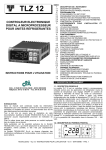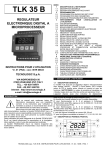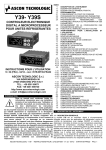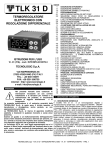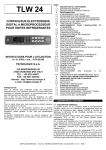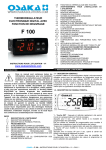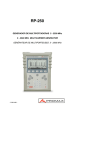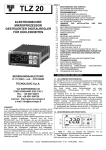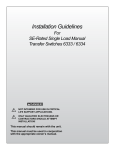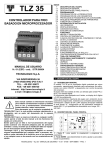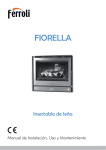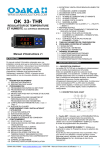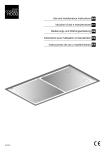Download TLY 27- EC - bei der EURO COLD CS GmbH
Transcript
TLY 27- EC AL Out OK + ISTRUZIONI PER L'USO OPERATING INSTRUCTIONS INSTRUCTIONS POUR L'UTILISATION BEDIENUNGSANLEITUNG MANUAL DE USUARIO vr. 01 - 10/04 - cod.: ISTR 06957 TECNOLOGIC S.p.A. VIA INDIPENDENZA 56 - 27029 VIGEVANO (PV) - ITALY TEL.: +39 0381 69871 FAX: +39 0381 698730 e-mail: [email protected] PREMESSA Nel presente manuale sono contenute le informazioni necessarie ad una corretta installazione e le istruzioni per l'utilizzo e la manutenzione del prodotto, si raccomanda pertanto di leggerlo attentamente e di conservarlo. La presente pubblicazione è di esclusiva proprietà della TECNOLOGIC S.p.A. la quale pone il divieto assoluto di riproduzione e divulgazione, anche parziale, se non espressamente autorizzata. La TECNOLOGIC S.p.A. si riserva di apportare modifiche estetiche e funzionali in qualsiasi momento e senza alcun preavviso. Qualora un guasto o un malfunzionamento dell'apparecchio possa creare situazioni pericolose o dannose per persone, cose o animali si ricorda che l'impianto deve essere predisposto con dispositivi aggiuntivi atti a garantire la sicurezza. La Tecnologic S.p.A. ed i suoi legali rappresentanti non si ritengono in alcun modo responsabili per eventuali danni a persone, cose o animali derivanti da manomissioni, uso improprio, errato o comunque non conforme alle caratteristiche dello strumento. FOREWORD This manual contains the information necessary for the product to be installed correctly and also instructions for its maintenance and use; we therefore recommend that the utmost attention is paid to the following instructions and to save it. This document is the exclusive property of TECNOLOGIC S.p.A. which forbids any reproduction and divulgation , even in part, of the document, unless expressly authorized. TECNOLOGIC S.p.A. reserves the right to make any formal or functional changes at any moment and without any notice. Whenever a failure or a malfunction of the device may cause dangerous situations for persons, thing or animals, please remember that the plant has to be equipped with additional devices which will guarantee safety. Tecnologic S.p.A. and its legal representatives do not assume any responsibility for any damage to people, things or animals deriving from violation, wrong or improper use or in any case not in compliance with the instrument’s features. INTRODUCTION Dans ce manuel sont contenues toutes les informations nécessaires pour une installation correcte et les instructions pour l’utilisation et l’entretien du produit, on recommande donc de lire bien attentivement les instructions suivantes et de le conserver. Cette publication est de propriété exclusive de la Société TECNOLOGIC S.p.A. qui interdit absolument la reproduction et la divulgation, même partielle, si elle n’est pas expressément autorisée. La Société TECNOLOGIC S.p.A. se réserve d’apporter des modifications esthétiques et fonctionnelles à tout moment et sans aucun préavis. Si un dommage ou un mauvais fonctionnement de l’appareil crée des situations dangereuses aux personnes, choses ou aux animaux, nous rappelons que l’installation doit être prévue de dispositifs électromécaniques supplémentaires en mesure de garantir la sécurité. La Société Tecnologic S.p.A. et ses représentants légaux ne se retiennent en aucune façon responsables pour des dommages éventuels causés à des personnes ou aux choses et animaux à cause de falsication, d’utilisation impropre, erronée ou de toute façon non conforme aux caractéristiques de l’instrument. VORWORT In der vorliegenden Anleitung sind alle Angaben enthalten, die für eine einwandfreie Installation und Verwendung sowie Wartung des Produktes erforderlich sind. Daher sollten die nachstehenden Anweisungen aufmerksam gelesen werden. Alle Rechte der vorliegenden Unterlagen sind vorbehalten. Nachdruck auch auszugsweise verboten, soweit nicht ausdrücklich zuvor von TECNOLOGIC S.p.A. genehmigt. Falls eine Betriebsstörung des Gerätes Personenoder Sachschäden verursachen kann, muss die Anlage mit zusätzlichen elektromechanischen Schutzeinrichtungen abgesichert werden. TECNOLOGIC S.p.A. behält sich das Recht vor, jederzeit ohne besondere Anzeige jene Änderungen vorzunehmen, die sie als notwendig erachtet. Die Firma Tecnologic S.p.A. und ihre gesetzlichen Vertreter weisen jede Haftung für Personen- oder Sachschäden von sich, die auf Abänderungen, unsachgemäße, falsche oder nicht den Merkmalen des Gerätes entsprechende Verwendung zurückzuführen sind. INTRODUCCION Este manual contiene la información necesaria para instalar correctamente el equipo y tambien para su uso y mantenimiento: recomendamos prestar atención a estas instrucciones. Este documento es de exclusiva propiedad de TECNOLOGIC S.p.A. la cual prohibe cualquier reproducción y divulgación, aún en parte, del documento sin la expresa autorización. TECNOLOGIC S.p.A. se reserva el derecho a cualquier modificación parcial o total de este manual y de las funciones del equipo, sin aviso previo. Donde quiera que un fallo ó mal funcionamiento del equipo pueda ocasionar una situación peligrosa para las personas, animales o cosas, recordar que la instalación debe ser equipada con otros equipos que garanticen la seguridad. Tecnologic S.p.A. y sus representantes legales no asumen ninguna responsabilidad por cualquier daño a personas, animales o cosas, derivado de la violación, error o uso incorrecto ni en cualquier caso no de acuerdo con las caracteristicas del equipo. TECNOLOGIC - TLY27 EC - OPERATING INSTRUCTIONS - Vr. 01 - 10/04 - ISTR 06957 - PAG. 1 1 - DESCRIZIONE STRUMENTO 5 AL 3 7 2 4 8 1 OK + Out 6 1 - Tasto P : Utilizzato per l'impostazione del Set point e per la programmazione dei parametri di funzionamento 2 - Tasto DOWN : Utilizzato per il decremento dei valori da impostare e per la selezione dei parametri. 3 - Tasto UP: Utilizzato per l'incremento dei valori da impostare e per la selezione dei parametri. 4 - Led OUT : Indica lo stato dell'uscita compressore (o del dispositivo di controllo della temperatura) on (acceso), off (spento) o inibita (lampeggiante) 5 - Led AL : Indica lo stato di allarme on. 6 - Led SET : Indica l’ingresso nella modalità di programmazione. 7 - Led OK : Indica che non vi sono allarmi in corso 8 - Led + : Indica che è in corso un allarme di alta temperatura. 2 - PROGRAMMAZIONE IMPOSTAZIONE RAPIDA DEL SET POINT - Premere il tasto P quindi rilasciarlo e il display visualizzerà SP1 alternato al valore impostato. Per modificarlo agire sui tasti UP per incrementare il valore o DOWN per decrementarlo. L'uscita dal modo di impostazione del Set avviene alla pressione del tasto P oppure automaticamente non agendo su alcun tasto per circa 10 secondi. PROGRAMMAZIONE DEL SET POINT E DELLA SOGLIA DI ALLARME DI ALTA TEMPERATURA - Per avere accesso ai parametri di funzionamento dello strumento occorre premere il tasto P e mantenerlo premuto per circa 5 secondi, trascorsi i quali si accenderà il led SET , il display visualizzerà il codice che ] identifica il primo gruppo di parametri (“ SP “) e con i tasti UP e DOWN sarà possibile selezionare il gruppo di parametri che si ] ] intende editare (“ AL“ o “ SP “). Una volta selezionato il gruppo di parametri desiderato premere il tasto P e verrà visualizzato il codice che identifica il parametro del gruppo selezionato ( “SP1” ] ] nel guppo “ SP “ e “HAL “ nel gruppo “ AL“). Premendo il tasto P, il display visualizzerà alternativamente il codice del parametro e la sua impostazione che potrà essere modificata con i tasti UP o DOWN. Impostato il valore desiderato premere nuovamente il tasto P: il nuovo valore verrà memorizzato e il display mostrerà nuovamente solo la sigla del parametro selezionato. Per tornare a selezionare un altro gruppo di parametri mantenere premuto il tasto UP o il tasto DOWN per circa 1 sec. trascorso il quale il display tornerà a visualizzare il codice del gruppo di parametri. Rilasciare quindi il tasto premuto e con i tasti UP e DOWN sarà possibile selezionare un altro gruppo. Per uscire dal modo di programmazione non agire su alcun tasto per circa 20 secondi, oppure mantenere premuto il tasto UP o DOWN sino ad uscire dalla modalità di programmazione. EN61010-1 per il funzionamento ad altitudini sino a 2000 m. L’utilizzo dello strumento in applicazioni non espressamente previste dalla norma sopra citata deve prevedere tutte le adeguate misure di protezione. Lo strumento NON può essere utilizzato in ambienti con atmosfera pericolosa (infiammabile od esplosiva) senza una adeguata protezione. Si ricorda che l’installatore deve assicurarsi che le norme relative alla compatibilità elettromagnetica siano rispettate anche dopo l’installazione dello strumento, eventualmente utilizzando appositi filtri. Qualora un guasto o un malfunzionamento dell'apparecchio possa creare situazioni pericolose o dannose per persone, cose o animali si ricorda che l'impianto deve essere predisposto con dispositivi elettromeccanici aggiuntivi atti a garantire la sicurezza. MONTAGGIO MECCANICO - Lo strumento, in contenitore 33 x 75 mm , è concepito per il montaggio ad incasso a pannello entro un involucro. Praticare quindi un foro 29 x 71 mm ed inserirvi lo strumento fissandolo con l’ apposita staffa fornita. Si raccomanda di montare l'apposita guarnizione per ottenere il grado di protezione frontale dichiarato. Evitare di collocare la parte interna dello strumento in luoghi soggetti ad alta umidità o sporcizia che possono provocare condensa o introduzione nello strumento di parti o sostanze conduttive. Assicurarsi che lo strumento abbia una adeguata ventilazione ed evitare l’installazione in contenitori dove sono collocati dispositivi che possano portare lo strumento a funzionare al di fuori dai limiti di temperatura dichiarati. Installare lo strumento il più lontano possibile da fonti che possono generare disturbi elettromagnetici come motori, teleruttori, relè, elettrovalvole ecc. COLLEGAMENTI ELETTRICI - Effettuare le connessioni collegando un solo conduttore per morsetto e seguendo lo schema riportato, controllando che la tensione di alimentazione sia quella indicata sullo strumento e che l'assorbimento degli attuatori collegati allo strumento non sia superiore alla corrente massima consentita. Lo strumento, essendo previsto per collegamento permanente entro un'apparecchiatura, non è dotato nè di interruttore nè di dispositivi interni di protezione da sovracorrenti. Si raccomanda pertanto di prevedere l’installazione di un dispositivo di protezione da sovracorrenti e di un interruttore/sezionatore di tipo bipolare, marcato come dispositivo di disconnessione, che interrompa l’alimentazione dell’apparecchio. Tale interruttore deve essere posto il più possibile vicino allo strumento e in luogo facilmente accessibile dall’utilizzatore. Inoltre si raccomanda di proteggere adeguatamente l’alimentazione di tutti i circuiti connessi allo strumento con dispositivi (es. fusibili) adeguati alle correnti circolanti. Si raccomanda di utilizzare cavi con isolamento appropriato alle tensioni, alle temperature e alle condizioni di esercizio e di fare in modo che i cavi relativi ai sensori di ingresso siano tenuti lontani dai cavi di alimentazione e da altri cavi di potenza al fine di evitare l’induzione di disturbi elettromagnetici. Se alcuni cavi utilizzati per il cablaggio sono schermati si raccomanda di collegarli a terra da un solo lato. Infine si raccomanda di controllare che i parametri impostati siano quelli desiderati e che l’applicazione funzioni correttamente prima di collegare le uscite agli attuatori onde evitare anomalie nell’impianto che possano causare danni a persone, cose o animali. SPDT 16A-AC1 Hold for 5 sec. NO NC C SPDT 5A-AC1 C NO NC INPUT 1 2 3 4 5 6 7 8 9 10 11 12 Hold for 2 sec. Hold for 2 sec. Hold for 2 sec. Hold for 2 sec. 3 - AVVERTENZE PER INSTALLAZIONE ED USO USO CONSENTITO -Lo strumento è stato concepito come apparecchio di misura e regolazione in conformità con la norma OUT AL SUPPLY NTC 4 - TABELLA PARAMETRI PROGRAMMABILI Par. Descrizione Range ] Gruppo SP (parametri relativi al Set Point) SP1 Set Point 1 ] Group AL (parameters relative to alarms) TECNOLOGIC - TLY27 EC - OPERATING INSTRUCTIONS - Vr. 01 - 10/04 - ISTR 06957 - PAG. 2 Def. HAL Soglia di allarme per alta temperatura 5 - PROBLEMI E MANUTENZIONE Segnalazioni di errore: Errore Motivo Azione la corretta La sonda può essere Verificare E1 interrotta o in connessione della sonda -E1 cortocircuito, oppure con lo strumento e quindi misurare un valore al di verificare il corretto fuori dal range consentito funzionamento della sonda Altre segnalazioni: Segnalazione Motivo Allarme di massima temperatura in corso HI PULIZIA: Si raccomanda di pulire lo strumento solo con un panno leggermente imbevuto d’acqua o detergente non abrasivo e non contenente solventi. 6 - Led SET : Indicates the input in programming mode. 7 - Led OK : Indicates that no alarms are in progress. 8 - Led + : Indicates that a high temperature alarm is in progress . 2 - PROGRAMMING FAST PROGRAMMING OF THE SET POINT - Press the key P then release it and the display will show SP 1 alternating with the set value. To change it press the UP key to increase the value or DOWN to decrease it. Exiting the Set mode is achieved by pressing the P key or automatically if no key is pressed for 15 seconds. PROGRAMMING OF THE SET POINT AND OF THE HIGH TEMPERATURE THRESHOLDS - To access the instrument’s function parameters, press the key P and keep it pressed for about 5 seconds, after which the SET led will light up, the display will visualised the code that identifies the first group of parameters ] (“ SP “) and the group of parameters that are to be edited are ] ] selected by pressing the UP and DOWN keys (“ AL“ o “ SP “). Once the group of parameters has been selected, press the P and the code that identifies the parameter in the selected group will be ] ] visualised ( “SP1” into “ SP “ and “HAL “ into “ AL“). Once the desired parameter has be selected, pressing the P key, the display will alternately show the parameter code and its setting that can be changed with the UP and DOWN keys. Once the desired value has been set, press the key P again: the new value will be memorised and the display will show only the abbreviation of the selected parameter. To return to select another group of parameters, keep the UP or the DOWN key pressed for about 1 second, after which the display will return to showing the code of the parameter group. Release the pressed key and using the UP and DOWN keys it will be possible to select another group . To exit the programming mode, do not press any key for about 20 seconds, or keep the UP or DOWN key pressed until it exits the programming mode. 6 - DATI TECNICI Alimentazione: 24 VAC/VDC, 100..240 VAC +/- 10% 50/60 Hz Assorbimento: 4 VA circa Ingresso/i: 1 ingresso per sonde di temperatura NTC (103AT-2, 10 K Ω @ 25 °C). Uscita/e : 2 uscite a relè. OUT SPDT (16A-AC1, 6A-AC3 250 VAC, 1HP 250VAC, 1/2HP 125 VAC) e AL SPDT (5A-AC1, 2A-AC3 250 VAC, 1/8HP 125-250 VAC). Vita elettrica uscite a relè: OUT: 50000 op. (om. VDE); AL : 100000 op. Categoria di installazione: II Categoria di misura : I Classe di protezione contro scosse elettriche: Frontale in Classe II Isolamenti: Rinforzato tra parti in bassa tensione (alimentazione e uscite a relè) e frontale; Rinforzato tra parti in bassa tensione (alimentazione e uscite a relè) e parti in bassissima tensione (ingressi); Rinforzato tra alimentazione e uscite a relè. Hold for 5 sec. Contenitore: Plastico autoestinguente UL 94 V0 Dimensioni : 33 x 75 mm, prof. 64 mm Peso : 115 g circa Hold for Hold for Installazione: Incasso a pannello in foro 29 x 71 mm 2 sec. 2 sec. 2 Connessioni: Morsetti a vite 2,5 mm Grado di protezione frontale: IP 65 con guarnizione Grado di polluzione: 2 Temperatura ambiente di funzionamento: 0 ... 50 °C Umidità ambiente di funzionamento: 30 ... 95 RH% senza Hold for Hold for condensazione 2 sec. 2 sec. Temperatura di trasporto e immagazzinaggio: -10 ... +60 °C Regolazione Temperatura: ON/OFF Range di misura: -50...109 °C 3 - INFORMATION ON INSTALLATION AND USE Precisione totale:+/- (0,5 % fs + 1 digit) PERMITTED USE - The instrument has been projected and Conformita': Direttiva CEE EMC 89/336 (EN 61326), Direttiva CEE manufactured as a measuring and control device to be used BT 73/23 e 93/68 (EN 61010-1) according to EN61010-1 for the altitudes operation until 2000 Omologazioni: C-UL (file n. E212227) ms.The use of the instrument for applications not expressly permitted by the above mentioned rule must adopt all the 1 - INSTRUMENT DESCRIPTION necessary protective measures. The instrument CANNOT be used in dangerous environments (flammable or explosive) without 5 adequate protection. The installer must ensure that EMC rules are AL 3 respected, also after the instrument installation, if necessary using proper filters. Whenever a failure or a malfunction of the device 7 2 may cause dangerous situations for persons, thing or animals, please remember that the plant has to be equipped with additional 4 1 devices which will guarantee safety. Out OK + 8 6 MECHANICAL MOUNTING - The instrument, in case 33 x 75 mm, is designed for flush-in panel mounting. Make a hole 29 x 71 mm 1 - Key P : Used for setting the Set point and for programming the and insert the instrument, fixing it with the provided special bracket. We recommend that the gasket is mounted in order to obtain the function parameters 2 - Key DOWN : Used for decreasing the values to be set and for front protection degree as declared. Avoid placing the instrument in environments with very high humidity levels or dirt that may create selecting the parameters. 3 - Key UP : Used for increasing the value to be set, and for condensation or introduction of conductive substances into the instrument. Ensure adequate ventilation to the instrument and selecting the parameters 4 - Led OUT : Indicates the compressor output status (or the avoid installation in containers that house devices which may overheat or which may cause the instrument to function at a higher temperature control device) on (on), off (off) or inhibited (flashing) temperature than the one permitted and declared. Connect the 5 - Led AL : Indicates the alarm status TECNOLOGIC - TLY27 EC - OPERATING INSTRUCTIONS - Vr. 01 - 10/04 - ISTR 06957 - PAG. 3 instrument as far away as possible from sources of electromagnetic disturbances such as motors, power relays, relays, solenoid valves, etc. ELECTRICAL CONNECTION - Carry out the electrical wiring by connecting only one wire to each terminal, according to the following diagram, checking that the power supply is the same as that indicated on the instrument and that the load current absorption is no higher than the maximum electricity current permitted. As the instrument is built-in equipment with permanent connection inside housing, it is not equipped with either switches or internal devices to protect against overload of current: the installation will include an overload protection and a two-phase circuit-breaker, placed as near as possible to the instrument, and located in a position that can easily be reached by the user and marked as instrument disconnecting device which interrupts the power supply to the equipment. It is also recommended that the supply of all the electrical circuits connected to the instrument must be protect properly, using devices (ex. fuses) proportionate to the circulating currents. It is strongly recommended that cables with proper insulation, according to the working voltages and temperatures, be used. Furthermore, the input cable of the probe has to be kept separate from line voltage wiring. If the input cable of the probe is screened, it has to be connected to the ground with only one side. We recommend that a check should be made that the parameters are those desired and that the application functions correctly before connecting the outputs to the actuators so as to avoid malfunctioning that may cause irregularities in the plant that could cause damage to people, things or animals. SPDT 16A-AC1 SPDT 5A-AC1 Installation category: II Measurement category: I Protection class against electric shock: Class II for Front panel Insulation: Reinforced insulation between the low voltage part (supply and relay outputs) and front panel; Reinforced insulation between the low voltage section (supply and relay outputs) and the extra low voltage section (inputs); Reinforced between supply and relay outputs. Housing: Self-extinguishing plastic, UL 94 V0 Dimensions: 33 x 75 mm, depth 64 mm Weight: 115 g approx. Mounting: Flush in panel in 29 x 71 mm hole 2 Connections: 2,5 mm screw terminals block Degree of front panel protection : IP 65 mounted in panel with gasket Pollution situation: 2 Operating temperature: 0 ... 50 °C Operating humidity: 30 ... 95 RH% without condensation Storage temperature: -10 ... +60 °C Temperature Control: ON/OFF mode Measurement range: -50...109 °C Overall accuracy: +/- (0,5 % fs + 1 digit) Compliance: ECC directive EMC 89/336 (EN 61326), ECC directive LV 73/23 and 93/68 (EN 61010-1) Approvals: C-UL (file n. E212227) 1 - DESCRIPTION DE L’INSTRUMENT 5 AL NO NC C C NO NC 1 2 3 4 5 6 7 8 9 10 11 12 OUT AL SUPPLY NTC 4 - PROGRAMMABLE PARAMETERS TABLE Par. Description Range ] Group SP (parameters relative to Set Point) SP1 Set Point 1 ] Group AL (parameters relative to alarms) temperature Alarm HAL High threshold 5 - PROBLEMS AND MAINTENANCE Error Signalling: Error Reason The probe Pr1 may be E1 interrupted or in short circuit, -E1 or may measure a value outside the range allowed 3 INPUT Def. Action Check the correct connection of the probe with the instrument and check the probe works correctly Other Signalling: Message Reason Maximum temperature alarm in progress HI CLEANING - We recommend cleaning of the instrument with a slightly wet cloth using water and not abrasive cleaners or solvents which may damage the instrument. 6 - TECHNICAL DATA Power supply: 24 VAC/VDC, 100..240 VAC +/- 10% 50/60 Hz Power consumption: 4 VA approx. Input: For temperature probes NTC (103AT-2, 10KΩ @ 25 °C) Outputs: 2 relay outputs: OUT SPDT (16A-AC1, 6A-AC3 250 VAC,1HP 250VAC, 1/2HP 125 VAC) and AL SPDT (5A-AC1, 2AAC3 250 VAC, 1/8HP 125-250 VAC). Electrical life for relay outputs: OUT: 50000 op. (om. VDE); AL : 100000 op. 7 2 1 4 8 Out OK + 6 1 - Touche P : Utilisée pour la programmation du Set point et pour la programmation des paramètres de fonctionnement. 2 - Touche DOWN : Utilisée pour le décroissement des valeurs à programmer et pour la sélection des paramètres. 3 - Touche UP : Utilisée pour l’accroissement des valeurs à programmer et pour la sélection des paramètres. 4 - Led OUT : Indique l’état de la sortie du compresseur (ou du dispositif de contrôle de la température) on (allumé), off (éteint) ou interdit (clignotant) 5 - Led AL : Indique l’état d’alarme on. 6 - Led SET : Indique l’entrée dans la modalité de programmation. 7 - Led OK : Indique qu’il n’y a pas d’alarmes en cours. 8 - Led + : Indique qu’une alarme de haute température est en cours 2 - PROGRAMMATION PROGRAMMATION RAPIDE DU SET POINT - Appuyer sur la touche P puis la relâcher et le display visualisera SP 1 alterné à la valeur établie. Pour le modifier, il faut agir sur les touches UP pour augmenter la valeur ou sur DOWN pour la diminuer. La sortie du mode d’établissement du Set s’effectue en appuyant sur la touche P ou bien automatiquement en agissant sur aucune touche pour 15 secondes environ. PROGRAMMATION DU SET POINT ET DE L’ALARME DE MAXIMUM - Pour avoir accès aux paramètres de fonctionnement de l’instrument, il faut appuyer sur la touche P et la laisser appuyer pour 5 secondes environ, après ce temps le led SET s’allumera, le display visualisera le code qui identifie le premier groupe de ] paramètres (“ SP “) et avec les touches UP et DOWN, on pourra ] sélectionner le groupe de paramètres que l’on veut éditer (“ AL“ ou ] “ SP “). Une fois que l’on a sélectionné le paramètre désiré, il faut appuyer sur la touche P et sera visualiser le code qui identifie le ] paramètre du groupe sélectionné ( “SP1” dans “ SP “ et “HAL” ] dans “ AL“). En appuyant sur la touche P, le display visualisera alternativement le code du paramètre et son établissement qui pourra être modifié par les touches UP ou DOWN. Après avoir TECNOLOGIC - TLY27 EC - OPERATING INSTRUCTIONS - Vr. 01 - 10/04 - ISTR 06957 - PAG. 4 établi la valeur désirée, il faut appuyer de nouveau sur la touche P: la nouvelle valeur sera mémorisée et le display montrera de nouveau seulement le sigle du paramètre sélectionné. Pour revenir à sélectionner un autre groupe de paramètres, il faut laisser appuyer la touche UP ou la touche DOWN pour 1 sec. environ, après ce temps le display visualisera de nouveau le code du groupe de paramètres. Relâcher ensuite la touche appuyée et avec les touches UP et DOWN on pourra sélectionner un autre groupe. Pour sortir du mode de programmation, il ne faut agir sur aucune touche pour 20 secondes environ, ou bien laisser appuyer la touche UP ou DOWN jusqu’à sortir de la modalité de programmation. connexes à l’instrument avec des dispositifs (ex. des fusibles) appropriés aux courants circulaires. On recommande d’utiliser des câbles ayant un isolement approprié aux tensions, aux températures et conditions d’exercice et de faire en sorte que le câble d’entrée reste distant des câbles d’alimentation et des autres câbles de puissance. Si le câble est blindé, il vaut mieux le brancher à la terre d’un seul côté. On recommande enfin de contrôler que les paramètres programmés sont ceux désirés et que l’application fonctionne correctement avant de brancher les sorties aux actuateurs afin d’éviter des anomalies dans l’installation qui peuvent causer des dommages aux personnes, choses ou animaux. SPDT 16A-AC1 SPDT 5A-AC1 Hold for 5 sec. NO NC Hold for 2 sec. Hold for 2 sec. C C NO NC 1 2 3 4 5 6 7 8 9 10 11 12 OUT AL SUPPLY Hold for 2 sec. Hold for 2 sec. 3 - AVERTISSEMENTS POUR L’INSTALLATION ET L’UTILISATION UTILISATION PERMISE - L’instrument a été fabriqué comme appareil de mesure et de réglage en conformité à la norme EN61010-1 pour le fonctionnement à altitudes jusque 2000 m. L’utilisation de l’instrument en applications non expressément prévues par la norme citée ci-dessus doit prévoir des mesures de protection appropriées. L’instrument NE peut PAS être utilisé dans un milieu dangereux (inflammable ou explosif) sans une protection appropriée. Nous rappelons que l’installateur doit s’assurer que les normes relatives à la compatibilité électromagnétique sont respectées même après l’installation de l’instrument, et éventuellement en utilisant des filtres spéciaux. Si un dommage ou un mauvais fonctionnement de l’appareil crée des situations dangereuses aux personnes, choses ou aux animaux, nous rappelons que l’installation doit être prévue de dispositifs électromécaniques supplémentaires en mesure de garantir la sécurité. MONTAGE MECANIQUE - L’instrument en boîtier de 33 x 75 mm est conçu pour le montage par panneau avec bride à l’intérieur d’un boîtier. Il faut faire un trou de 29 x 71 mm et y insérer l’instrument en le fixant avec sa bride donnée en équipement. Nous recommandons aussi de mettre la garniture appropriée pour obtenir le degré de protection frontale déclaree. Il faut éviter de placer la partie interne de l’instrument dans des lieux humides ou sales qui peuvent ensuite provoquer de la condensation ou une introduction dans l’instrument de pièces conductibles. Il faut s’assurer que l’instrument a une ventilation appropriée et éviter l’installation dans des récipients où sont placés des dispositifs qui peuvent porter l’instrument à fonctionner en dehors des limites déclarées de température. Installer l’instrument le plus loin possible des sources qui peuvent provoquer des dérangements électromagnétiques et aussi des moteurs, télérupteurs, relais, électrovannes, etc. BRANCHEMENTS ELECTRIQUES - Il faut effectuer les connexions en branchant un seul conducteur par borne et en suivant le schéma reporté, tout en contrôlant que la tension d’alimentation soit bien celle qui est indiquée sur l’instrument et que l’absorption des actuateurs reliés à l’instrument ne soit pas supérieure au courant maximum permis. Puisque l’instrument est prévu pour un branchement permanent dans un appareillage, il n’est doté ni d’interrupteur ni de dispositifs internes de protection des surintensités. L’installation doit donc prévoir un interrupteur/sectionneur biphasé placé le plus près possible de l’appareil, dans un lieu facilement accessible par l’utilisateur et marqué comme dispositif de déconnexion de l’instrument et de protéger convenablement l’alimentation et tous les circuits INPUT NTC 4 - TABLEAU DES PARAMETRES PROGRAMMABLES Par. Description Range ] Groupe SP (paramètres relatifs au Set Point) SP1 Set Point 1 ] Groupe AL (paramètres relatifs aux alarmes) HAL Seuil d’alarme pour haute température 5 - PROBLEMES ET ENTRETIEN Signalisations d’erreur : Erreur Motivation La sonde peut être E1 interrompue ou en court -E1 circuit ou bien mesurer une valeur en dehors du range permis Def. Action Vérifier la connexion correcte de la sonde avec l’instrument et ensuite vérifier le fonctionnement correct de la sonde Autres signalisations : Signalisation Motivation Alarme de maximum température en cours HI NETTOYAGE - On recommande de nettoyer l’instrument seulement avec un tissu légèrement imbibé d’eau ou de détergent non abrasif et ne contenant pas de solvants. 6 - DONNEES TECHNIQUES Alimentation : 24 VAC/VDC, 100..240 VAC +/- 10% 50/60 Hz Absorption : 4 VA environ Entrée/s : 1 entrée pour sondes de température NTC (103AT-2, 10 K Ω @ 25 °C) Sorties : 2 sorties à relais : OUT SPDT 16A-AC1, 6A-AC3 250 VAC) et AL SPDT (5A-AC1, 2A-AC3 250 VAC). Vie électrique sorties à relais : OUT 100000 op. ; AL: 100000 op. Catégorie de l’installation : II Catégorie de mesure : I Classe de protection contre les décharges électriques : Frontale en Classe II Isolements : Renforcé entre les parties en basse tension (alimentation et sorties à relais) et frontale; Renforcé entre les parties en basse tension (alimentation et sorties à relais) et les parties en très très basse tension (entrées); Renforcé entre l’alimentation et les sorties à relais. Boîtier : en matière plastique avec autoextinction UL 94 V0 Dimensions : 33 x 75 mm, prof. 64 mm Poids : 115 g environ Installation : A encaissement à panneau (épaisseur max. 29 ou 12 mm en fonction de la broche utilisée) avec trou de 29 x 71 mm 2 Raccordements : Bornes à vis 2,5 mm Degré de protection frontale: IP 65 avec garniture TECNOLOGIC - TLY27 EC - OPERATING INSTRUCTIONS - Vr. 01 - 10/04 - ISTR 06957 - PAG. 5 Degré de pollution : 2 Température ambiante de fonctionnement : 0 ... 50 °C Humidité ambiante de fonctionnement : 30 ... 95 RH% sans condensation Température de transport et stockage : -10 ... +60 °C Réglage de la température : ON/OFF Etendue de mesure : -50...109 °C Précision totale: +/- (0,5 % fs + 1 digit) Conformité : Directive CEE EMC 89/336 (EN 61326), Directive CEE BT 73/23 et 93/68 (EN 61010-1) Homologations : C-UL (file n. E212227) Hold for 5 sec. Hold for 2 sec. Hold for 2 sec. Hold for 2 sec. Hold for 2 sec. 1 - BESCHREIBUNG DES GERÄTES 5 AL 3 7 2 4 8 1 Out OK + 6 1 - Taste P: Wird zur Eingabe des Sollwertes und zur Programmierung der Betriebsparameter verwendet 2 - Taste DOWN: Anhand dieser Taste wird der einzustellende Wert reduziert bzw. ein Parameter angewählt. 3 - Taste UP: Anhand dieser Taste wird der einzustellende Wert erhöht bzw. ein Parameter angewählt 4 - Led OUT: Diese gibt den Ausgangszustand des Verdichters an (bzw. der Temperaturüberwachungseinrichtung) on (ein), off (aus) oder gesperrt (blinkend) 5 - Led AL: Gibt den Alarmzustand on. 6 - Led SET: Signalisiert den Zugriff auf den Programmiermodus und die Programmierebene der Parameter. 7 - Led OK : Gibt an, dass momentan keine Alarme bestehen. 8 - Led + : Gibt an, dass gerade ein Höchstwertalarm eingetreten ist. 2 - PROGRAMMIERUNG SCHNELLEINSTELLUNG DER SOLLWERT - Die Taste P kurz drücken; auf der Anzeige erscheint SP 1 und abwechselnd der eingestellte Wert. Erhöht wird der Wert anhand der Taste UP, reduziert wird er anhand der Taste DOWN. Verlassen wird der Schnelleinstellmodus durch Drücken der Taste P oder auch automatisch, wenn ca. 15 Sekunden lang keine Taste mehr gedrückt wurde. Daraufhin kehrt die Anzeige zum normalen Betriebsmodus zurück. EINGABE DER SOLLWERTE UND DER ALARMGRENZWERT BEI HOHER TEMPERATUR - Zur Programmierung der Parameter des Regler ist die Taste P ca. 5 Sekunden gedrückt zu halten; danach leuchtet die Led SET und auf der Anzeige erscheint die ] Abkürzung der ersten Parametergruppe (“ SP “); anhand der Tasten UP und DOWN kann die zu verändernde Parametergruppe ] ] angezeigt werden (“ AL“ oder “ SP “). Wurde die gewünschte Parametergruppe angewählt, muss diese mit der Taste P bestätigt werden, damit die Abkürzung des Parameters dieser Gruppe ] ] angezeigt wird. ( “SP1” in “ SP “ und “HAL “ in “ AL“). Drücken der Taste P bestätigt; auf der Anzeige erscheint abwechselnd die Parameterabkürzung und der eingestellte Wert, der wiederum durch Drücken der Tasten UP oder DOWN verändert werden kann. Wurde der gewünschte Wert eingestellt, ist erneut die Taste P zu drücken: Der neue Wert wird nun gespeichert und auf der Anzeige erscheint lediglich die Abkürzung des angewählten Parameters. Soll eine neue Parametergruppe geöffnet werden, ist die Taste UP oder die Taste DOWN ca. 1 Sekunde lang gedrückt zu halten; daraufhin erscheint auf der Anzeige die Abkürzung der Programmgruppe. Die gedrückte Taste loslassen; anhand der Tasten UP und DOWN kann nun eine neue Parametergruppe angewählt werden. Der Programmiermodus wird verlassen, wenn ca. 20 Sekunden lang keine Taste mehr gedrückt wird, bzw. indem die Taste UP oder DOWN solange gedrückt gehalten wird, bis der Programmiermodus verlassen wurde. 3 - HINWEISE ZUR INSTALLATION UND ZUM GEBRAUCH BESTIMMUNGSGEMÄSSER GEBRAUCH - Das Gerät wurde als Mess- und Regelgerät konzipiert und entspricht der Vorschrift EN61010-1 für den Betrieb bis zu 2000 m Höhe. Bei einem Gebrauch des Gerätes für nicht ausdrücklich in dieser Vorschrift vorgesehene Anwendungen müssen sämtliche Schutzmaßnahmen getroffen werden. Das Gerät darf ohne angemessene Absicherung NICHT in explosionsgefährdeter Atmosphäre verwendet werden (entzündbarer oder explosiver Atmosphäre). Der Installateur hat sicherzustellen, dass die Normen in bezug auf elektromagnetische Kompatibilität auch nach Installation des Gerätes erfüllt werden, ggf. durch Verwendung von Spezialfiltern. Falls eine Betriebsstörung des Gerätes Personen- oder Sachschäden verursachen kann, muss die Anlage mit zusätzlichen elektromechanischen Schutzeinrichtungen abgesichert werden. MECHANISCHER EINBAU - Das Gerät befindet sich in einem 33 x 75 mm Gehäuse und ist für den Schalttafeleinbau vorgesehen. Es wird in eine 29 x 71 mm große Aussparung gesetzt und daraufhin mit dem vorgesehenen Klemmbügel befestigt. Es wird darauf hingewiesen, dass zur Gewährleistung der angegebenen FrontSchutzart die zur Ausstattung gehörende Dichtung zu verwenden ist. Die Innenseite des Gerätes sollte weder Staub noch starker Feuchtigkeit ausgesetzt werden, da sich Kondenswasser bilden könnte oder in das Geräteinnere leitende Teile oder Stoffe gelangen könnten. Außerdem ist sicherzustellen, dass das Gerät ausreichend belüftet ist; ein Einbau in Bereichen, in denen das Gerät bei Über- bzw. Unterschreitung der vorgegebenen Betriebstemperaturgrenzwerte betrieben werden könnte, ist unbedingt zu vermeiden. Das Gerät ist so weit wie möglich entfernt von Quellen, die starke elektromagnetische Störungen verursachen könnten, d.h. von Motoren, Schützen, Relais, Magnetventilen usw. zu installieren. STROMANSCHLUSS - Das Gerät anschließen; dazu jeweils einen Leiter je Klemme anschließen und entsprechend beiliegendem Anschlussschema vorgehen; dabei sicherstellen, dass die Netzspannung den Hinweisen auf dem Gerät entspricht und der Anschlusswert der am Gerät angeschlossenen Verbraucher den vorgesehenen Höchstwert nicht überschreitet. Da das Gerät für einen permanenten Anschluss in einer Einrichtung vorgesehen ist, verfügt es weder über Schalter noch über interne Schutzvorrichtungen gegen Überstrom. Daher ist ein als Abschalteinrichtung markierter bipolarer Schalter/Trennschalter vorzusehen, der die Stromversorgung zum Gerät unterbricht. Dieser Schalter muss so nah wie möglich am Gerät und an einer für den Betreiber gut erreichbaren Stelle installiert werden. Außerdem sind alle am Gerät angeschlossenen Kreisläufe durch geeignete, den vorhandenen Stromwerten entsprechende Vorrichtungen (z.B. Sicherungen) abzusichern. Es sind Kabel zu verwenden, die über geeignete, den Spannungen, Temperaturen und Betriebsbedingungen entsprechende Isolierung verfügen und es muss darauf geachtet werden, dass die Kabel der Eingangsfühler separat von den Stromkabeln und anderen Leistungskabeln verlegt werden, um eine Induktion elektromagnetischer Störungen zu vermeiden. Bei Verwendung von abgeschirmten Kabeln sind diese nur einseitig zu erden. Vor Anschluss der Ausgänge an die Verbraucher ist unbedingt sicherzustellen, dass die eingestellten Parameter auch tatsächlich den gewünschten Parameterwerten entsprechen und die TECNOLOGIC - TLY27 EC - OPERATING INSTRUCTIONS - Vr. 01 - 10/04 - ISTR 06957 - PAG. 6 Anwendung richtig funktioniert, damit keine Störungen in der Anlage verursacht SPDT 16A-AC1 SPDT 5A-AC1 1 - DESCRIPCION DEL EQUIPO 5 AL NO NC C C NO NC INPUT 1 2 3 4 5 6 7 8 9 10 11 12 OUT AL SUPPLY NTC 4 - TABELLE DER PROGRAMMIERBAREN PARAMETER Par. Beschreibung ] Gruppe SP (Parameter des Sollwertes) SP1 Sollwert 1 ] Gruppe AL (Parameter der Alarme) HAL Alarmgrenzwert bei hoher Temperatur Range Def. 5 - STÖRUNGEN UND WARTUNG Fehlermeldungen: Error Ursache Abhilfe Der Fühler kann unterbrochen Den Fühleranschluss E1 oder kurzgeschlossen sein am Gerät und die -E1 oder einen Wert messen, der Funktionstüchtigkeit außerhalb des zulässigen des Fühlers Bereichs liegt. überprüfen. Weitere Meldungen: Meldung Ursache Höchstwerttemperaturalarm läuft gerade HI REINIGEN - Das Gerät sollte mit einem feuchten Tuch mit etwas Wasser oder mit einem lösungsmittelfreien Reinigungsmittel gereinigt werden. 3 7 2 4 8 1 Out OK + 6 1 - Tecla P : para ajustar la preselección y programar los parámetros. 2 - Tecla DOWN : para decrementar el valor a ajustar y para seleccionar los parámetros 3 - Tecla UP : Para incrementar el valos a ajustar y para seleccionar los parámetros 4 - Led OUT : Indica el estado del compresor (o el control de la temperatura) encendido (on), apagado (off) o inhibido (intermitente). 5 - Led AL : Indica el estado de la alarma activo 6 - Led SET : Indica la entrada en modo programación. 7 - Led OK : Indica el estado de la alarma desactivo 8 - Led + : Indica el estado de Alarma de máxima activo 2 - PROGRAMACION PROGRAMACIÓN RAPIDA DEL SET POINT- Pulsar la tecla P, soltarla y en el display aparece SP1 alternadose con el valor ajustado. Para cambiarlo pulsar UP para incrementar el valor o DOWN para decrementarlo. El valor ajustado es aceptado pulsando la tecla P o automáticamente despues de 10 seg. sin presionar ninguna tecla. PROGRAMACION DEL SET POINT Y DE ALARMA DE ALTA TEMPERATURA - Para acceder a la programacion de los parámetros, presionar la tecla P y mantenerla presionada más de 5 seg., en cuyo momento el led SET se enciende,el display visualiza ] el código que identifica al primer grupo de parámetros (“ SP “) y con las teclas “UP” y “DOWN” será posible seleccionar el grupo de ] ] parámetros que se quiere editar (“ AL“ o “ SP “). Una vez seleccionado el grupo de parámetros deseado, pulsar la tecla “P” y será visualizado el código que identifica el parámetro del grupo seleccionado. Pulsando la tecla “P”, el display visualizará alternativamente el código del parámetro y su programación podrá ser modificada con las teclas “UP” o “DOWN”. Programado el valor deseado, pulsar nuevamente la tecla “P”: el nuevo valor será memorizado y el display mostrará nuevamente la sigla del parámetro seleccionado. Para volver a seleccionar otro grupo de parámetro, mantener pulsada la tecla ”UP” o la tecla “DOWN” cerca de 1 seg. transcurridos los cuales el display volverá a visualizar el código del grupo de parámetros. Soltar la tecla pulsada y con las teclas “UP” y “DOWN” será posible seleccionar otro grupo. Para salir del modo de programacion, no pulsar ninguna tecla durante al menos 20 seg., o mantener la tecla UP o la DOWN pulsadas hasta que se salga del modo programación. 6 - TECHNISCHE DATEN Stromversorgung: 24 VAC/VDC, 100..240 VAC +/- 10% 50/60 Hz Aufnahme: ca. 4 VA. Eingang: 1 Eingänge für Temperaturfühler NTC (103AT-2, 10 K Ω @ 25°C); Ausgänge: 2 Relaisausgänge: OUT SPDT (16A-AC1, 6A-AC3 250 VAC,1HP 250VAC, 1/2HP 125 VAC) und AL SPDT (5A-AC1, 2AAC3 250 VAC, 1/8HP 125-250 VAC). Elektrische Lebensdauer der Relaisausgänge: OUT SPDT: 50000 op. (om. VDE); AL: 100000 op. Installationskategorie: II Messkategorie: I Schutzart gegen Stromschläge: Frontseitig Klasse II Isolierungen: Verstärkung zwischen den Niederspannungsbauteilen (Spannung und Relaisausgänge) und Frontseite. Verstärkt zwischen den Niederspannungsbauteilen (Spannung und Relaisausgänge) und Unterspannungsbauteilen (Eingänge); Verstärkung zwischen Spannung und Hold for Relaisausgängen. 5 sec. Gehäuse: UL 94 V0 Kunststoff Einbaumaße: 33 x 75 mm, Einbautiefe 64 mm Gewicht: ca. 115 g Hold for Hold for 2 sec. 2 sec. Einbau: Schalttafel (Max. Stärke 29 oder 12 mm je nach dem verwendeten Klemmbügel) in 29 x 71 mm Aussparung 2 Anschluss: Schraubklemmleiste 2,5 mm Front-Schutzart: IP 65 mit Dichtung Umweltbelastung: 2 Betriebstemperatur: 0 ... 50 °C Hold for Hold for 2 sec. 2 sec. Feuchte im Betriebsbereich: 30 ... 95 RH% nicht kondensierend Transport- und Lagertemperatur: -10 ... +60 °C Temperaturregelung: EIN/AUS Messbereich: -50...109 °C 3 - INFORMACION DE INSTALACION Y USO Gesamtgenauigkeit::+/- (0,5 % fs + 1 digit) USO PERMITIDO - El equipo ha sido proyectado y fabricado como Konformität: Vorschrift EWG EMC 89/336 (EN 61326), Vorschrift instrumento de medida y control de acuerdo con EN61010-1 para EWG NS 73/23 und 93/68 (EN 61010-1) alturas máximas de 2000 ms. El uso del equipo en aplicaciones no Zulassung: C-UL (file n. E212227) TECNOLOGIC - TLY27 EC - OPERATING INSTRUCTIONS - Vr. 01 - 10/04 - ISTR 06957 - PAG. 7 permitidas expresamente por la norma mencionada, debe adoptar toda clase de medidas protectoras. El instrumento NO PUEDE ser usado en ambientes peligrosos (inflambles o explisivos), sin la adecuada protección. El instalador debe asegurarse de que se respetan las normas EMC, si es necesario usar los filtros adecuados. Donde quiera que un fallo ó mal funcionamiento del equipo pueda ocasionar una situación peligrosa para las personas, animales o cosas, recordar que la instalación debe ser equipada con otros equipos que garanticen la seguridad. MONTAJE MECANICO - El instrumento, en contenedor 33 x 75 mm , está concebido para el montaje en panel dentro de una carcasa. Practicar un agujero 29 x 71 mm e insertar el instrumento fijándolo con el adecuado estribo provisto. Se recomienda montar la adecuada guarnición para obtener el grado de protección frontal declarado. Evitar colocar la parte interna del instrumento en lugares sometidos a alta humedad o suciedad que pueden provocar condensación o introducir en el instrumento partes o substancias conductoras. Asegurarse de que el instrumento tenga una adecuada ventilación y evitar la instalación en contenedores donde se coloquen aparatos que puedan llevar al instrumento a funcionar fuera de los límites de temperatura declarados. Instalar el instrumento lo más lejano posible de fuentes que generen interferencias electromagnéticas como motores, relés, electroválvulas, etc.. CONEXIONES ELÉCTRICAS - Efectuar las conexiones conectando un solo conductor por borne y siguiendo el esquema indicado, controlando que la tensión de alimentación sea aquella indicada para el instrumento y que la absorción de los actuadores conectados al instrumento no sea superior a la corriente máxima admisible. El instrumento, concebido para estar conectado permanentemente dentro de un panel, no está dotado ni de interruptor ni de dispositivos internos de protección a las sobreintensidades. Se recomienda por tanto de proveer a la instalación de un interruptor/seccionador de tipo bipolar, marcado como dispositivo de desconexión, que interrumpa la alimentación del aparato. Dicho interruptor debe ser puesto lo más cercano posible del instrumento y en lugar fácilmente accesible por el usuario. Además se recomienda proteger adecuadamente todos los circuitos conectados al instrumento con dispositivos (ej. fusibles) adecuados para la corriente que circula. Se recomienda utilizar cables con aislamiento apropiado a las tensiones, a las temperaturas y condiciones de ejecución, de modo que los cables relativos a los sensores de entrada se alejen de los cables de alimentación y de otros cables de potencia a fin de evitar la inducción de interferencias electromagnéticas. Si algunos cables utilizados para el para el cableado está protegidos, se recomienda conectarlos a tierra de un solo lado. Finalmente se recomienda controlar que los parámetros programados sean aquellos deseados y que la aplicación funciona correctamente antes de conectar las salidas a los actuadores para evitar anomalías en la instalación que puedan causar daños a personas, cosas o animales. SPDT 16A-AC1 NO NC C 5 - PROBLEMAS Y MANTENIMIENTO Errores: Error Razón Acción La sonda puede estar Comprobar la conexión E1 interrumpida o en de la sonda y comprobar -E1 cortocircuito, o mide un que la sonda trabaja valor fuera de rango correctamente Otras señales: Mensaje Razón Alarma de máxima activo HI LIMPIEZA - Recomendamos limpiar el equipo con un trapo húmedo con agua sin usar productor abrasivos o disolventes que puedan dañar al equipo. 6 - CARACTERISTICA TECNICAS Alimentación: 24 VAC/VDC, 100..240 VAC +/- 10% 50/60 Hz Potencia consumida: 4 VA aproximadamente. Entradas: 1 para sondas NTC (103AT-2, 10KΩ @ 25 °C) Salidas: 2 Relé: OUT SPDT (16A-AC1, 6A-AC3 250 VAC, 1HP 250VAC, 1/2HP 125 VAC) y AL SPDT (5A-AC1, 2A-AC3 250 VAC, 1/8HP 125-250 VAC). Vida eléctrica de los relés: OUT: 50000 operaciones. (om. VDE) ; AL: 100000 operaciones. Categoría de instalación: II Categoría de medida: I Clase de protección eléctrica: Clase II (Panel frontal) Aislamiento: Aislamiento reforzado entre partes de baja tensión (Alimentación y salida por relé) y el panel frontal; Aislamiento reforzado entre las partes de baja tensión (Alimentación y relé de salida) y la sección de muy baja tensión (entradas); Aislamiento reforzado entre alimentación y relé de salida. Carcasa: Plástico autoextinguible, UL 94 V0 Dimensiones: 33 x 75 mm, prof. 64 mm Peso: 115 g approx. Instalación: Empotrable en panel de 29 x 71 mm Conexiones: 2,5 mm2 regleta de tornillos Grado de protección frontal: IP 65 Polución: 2 Temperatura de operación: 0 ... 50 °C Humedad de operación: 30 ... 95 RH% sin condensación Temperatura de almacenamiento: -10 ... +60 °C Control de temperatura: ON/OFF Rango de medida: -50...109 °C Precisión: +/- (0,5 % fs + 1 digit) Directivas: ECC EMC 89/336 (EN 61326), ECC LV 73/23 y 93/68 (EN 61010-1) Homologaciones: C-UL (file n. E212227) SPDT 5A-AC1 C NO NC INPUT 1 2 3 4 5 6 7 8 9 10 11 12 OUT AL SUPPLY NTC 4 - TABLA DE PARAMETROS Par. Descripción Range ] Grupo SP (Parámetros relacionados con el Set Point) SP1 Set Point 1 ] Grupo AL (parámetros relacionados con la Alarma) HAL Alarma relativa de alta temperatura Def. TECNOLOGIC - TLY27 EC - OPERATING INSTRUCTIONS - Vr. 01 - 10/04 - ISTR 06957 - PAG. 8








